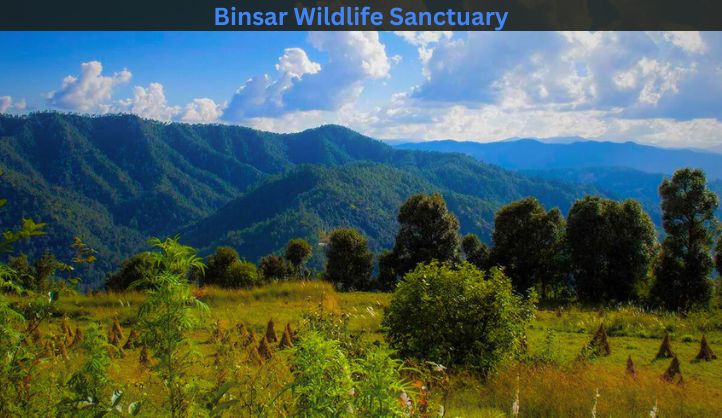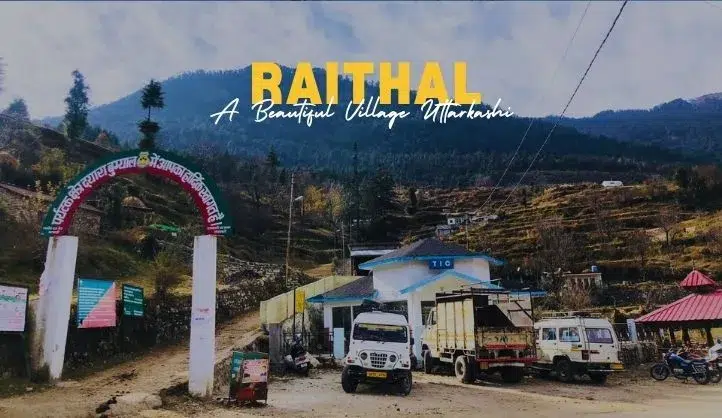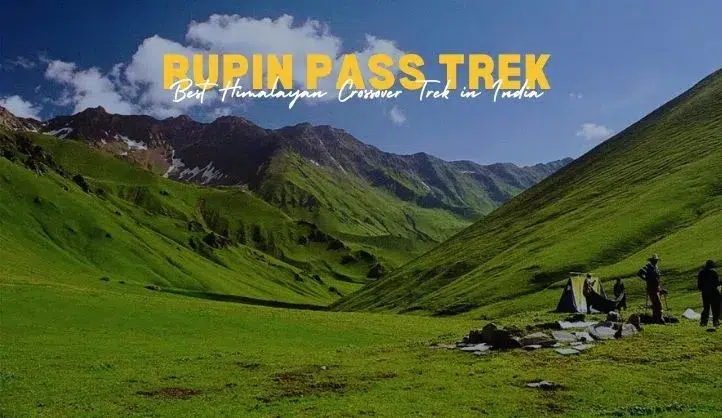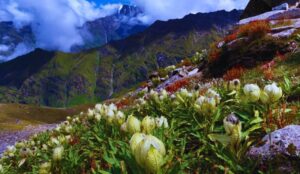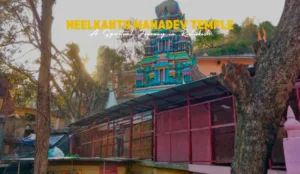Nestled amidst the verdant embrace of the Kumaon Hills in Uttarakhand, India, lies the Binsar Wildlife Sanctuary – a treasure trove of biodiversity and breathtaking beauty. Established in 1988, this haven for flora and fauna sprawls over 45.59 square kilometers, captivating visitors with its diverse ecosystems, rich history, and panoramic Himalayan vistas.
From Royal Retreat to Wildlife Refuge
Binsar’s story is interwoven with time. Legend has it that the name originates from “Bineshwar,” a local name for Lord Shiva. Historical records reveal that the Chand Dynasty, who ruled Kumaon from the 7th to 18th centuries AD, chose Binsar as their summer capital. The remnants of their reign can still be glimpsed in the ancient temples scattered throughout the sanctuary. The British Raj, too, recognized the sanctuary’s charm and established their own summer estates within the forested embrace.
How to reach Binsar Wildlife Sanctuary
By Air
The nearest airport is Pantnagar Airport (PGH), located around 152 kilometers from Binsar. Taxis are easily available from the airport to Binsar. You can also fly to Dehradun Airport (DED) or Delhi Airport (DEL), which are well-connected to major cities in India. From there, take a taxi or car to reach Binsar.
By Train
Kathgodam Railway Station (KGM) is the nearest railhead, situated about 119 kilometers from Binsar. Several trains connect Kathgodam to major cities like Delhi, Lucknow, and Kolkata. Taxis and buses are readily available from Kathgodam to reach Binsar.
By Road
Binsar is well-connected by motorable roads with major destinations in Kumaon and cities of North India. Buses ply regularly from Haldwani, Almora, Nainital, and Delhi to Binsar. You can also hire a taxi from any of these locations.
Map of Binsar Wildlife Sanctuary
A Tapestry of Flora and Fauna
Binsar boasts a remarkable variety of plant life, with distinct ecosystems thriving at different altitudes. The lower regions are dominated by verdant pine forests, offering a cool and refreshing escape. As you ascend, the landscape transforms into a majestic tapestry of oak and rhododendron forests. During spring, these forests come alive with a vibrant explosion of colors, particularly the ruby-red rhododendrons that paint the hillsides in a breathtaking display. Binsar is home to over 250 species of flowering plants, 24 types of shrubs, and 7 varieties of grasses, creating a verdant paradise for nature enthusiasts.
A Realm of Enchanting Wildlife
The rich tapestry of flora provides a nurturing habitat for a diverse range of fauna. One of the most sought-after sightings in Binsar is the elusive leopard, a magnificent predator that roams the sanctuary’s dense forests. If you’re lucky, you might also catch glimpses of the barking deer, known for their distinctive alarm calls, or the majestic Himalayan serow, an agile goat-antelope that gracefully navigates the slopes. Wild boars, porcupines, yellow-throated martens, and the ubiquitous langurs and macaques are other residents of this vibrant wildlife sanctuary.
A Birder’s Paradise
Birdwatchers flock to Binsar for the opportunity to spot over 200 species of birds. The melodious calls of the Himalayan pheasants, the flash of the crimson sunbird, and the soaring silhouettes of eagles against the clear Himalayan sky are just a few of the avian delights that await visitors. Keen observers might even be fortunate enough to see the elusive lammergeier, a bearded vulture with an impressive wingspan, or the colorful Himalayan monal pheasant, a sight to behold with its iridescent plumage.
Unveiling the Sanctuary’s Treasures
While wildlife spotting is a major draw, Binsar offers a plethora of other experiences. For history buffs, the sanctuary is home to a museum that sheds light on the region’s rich flora and fauna. Hikers can embark on trails that weave through the dense forests, offering opportunities to commune with nature and soak in the serenity of the surroundings. Zero Point, the highest point in the sanctuary, rewards visitors with awe-inspiring panoramic views of the majestic Himalayan peaks, including Nanda Devi, Chaukhamba, and Trishul.
Responsible Tourism
Binsar’s pristine beauty is a gift to be cherished and protected. Responsible tourism practices are vital to ensure the sanctuary’s health and well-being. Visitors are encouraged to stick to designated trails, minimize noise pollution, and dispose of waste responsibly. Opting for eco-friendly accommodations and using local guides are other ways to contribute to the sanctuary’s conservation efforts.
A Timeless Enchantment
Binsar Wildlife Sanctuary is more than just a wildlife refuge; it’s a place where history whispers through ancient ruins, nature unveils its breathtaking beauty, and the call of the wild awakens a sense of adventure. Whether you’re a seasoned wildlife enthusiast, a passionate hiker, or simply seeking a tranquil escape amidst the Himalayas, Binsar offers an experience that lingers long after you depart. So, pack your bags, embrace the spirit of adventure, and prepare to be captivated by the timeless enchantment of Binsar.
Things to do in Binsar Wildlife Sanctuary
Wildlife Safari – Embark on a jeep safari or guided nature walk to explore the sanctuary’s diverse flora and fauna. Trained guides can help you spot animals and understand the intricate web of life within Binsar.
Birdwatching – With over 200 species of birds, Binsar is a paradise for birdwatchers. Carry your binoculars and prepare to be enthralled by the symphony of bird calls and the vibrant colors of these feathered residents.
Trekking – Lace up your hiking boots and explore the network of trails that wind through the sanctuary. Choose from easy nature walks to more challenging treks that lead to Zero Point, offering breathtaking Himalayan vistas.
Nature Photography – Capture the essence of Binsar’s beauty – the majestic mountains, the vibrant flora, and the elusive wildlife – through the lens of your camera.
Cultural Immersion – Visit the ancient temples scattered throughout the sanctuary, or explore nearby villages to get a glimpse into the rich Kumaoni culture and traditions.
Relaxation and Rejuvenation – Disconnect from the hustle and bustle of everyday life and soak in the serenity of the surroundings. Practice yoga or meditation amidst nature, or simply unwind with a good book in a secluded spot overlooking the Himalayas.
Nearby Places to Explore in Binsar Wildlife Sanctuary
Zero Point
As the name suggests, Zero Point is the highest point in the Binsar Wildlife Sanctuary, offering breathtaking 360-degree vistas of the majestic Himalayas. On a clear day, you can catch glimpses of Nanda Devi, Chaukhamba, Trishul, and other snow-capped peaks. Take a scenic hike or a jeep ride to reach this vantage point and be mesmerized by the panoramic Himalayan beauty.
Bineshwar Mahadev Temple
Nestled amidst the verdant embrace of Binsar, the Bineshwar Mahadev Temple is a 16th-century structure dedicated to Lord Shiva. The temple’s architecture reflects the influence of Katyuri and Khas styles, featuring intricate carvings and a serene atmosphere.
Katarmal Sun Temple
Located around 30 km from Binsar, the Katarmal Sun Temple is an architectural marvel dedicated to the Sun God Surya. Built-in the 8th-9th centuries AD, the temple is renowned for its unique architecture and its significance in the pantheon of Surya temples in India.
Jageshwar Dham
Embark on a spiritual journey to Jageshwar Dham, a complex of over 125 ancient Shiva temples nestled amidst a picturesque landscape, around 35 km from Binsar. Explore the intricate carvings on the temples, some dating back to the 7th-9th centuries AD, and immerse yourself in the spiritual aura of this historic site.
Kasar Devi Temple
Located around 20 km from Binsar, Kasar Devi Temple holds historical and spiritual significance. Explore the temple dedicated to Goddess Naina Devi and soak in the panoramic views of the surrounding valleys. Kasar Devi also has a reputation for being a center for yoga and meditation and offers a glimpse into the region’s vibrant culture.
Mukteshwar
Escape the hustle and bustle and head to Mukteshwar, a quaint hill station perched at an altitude of around 7000 feet. This serene getaway offers breathtaking views of the Himalayas, along with opportunities for trekking, birdwatching, and exploring temples like the Mukteshwar Dham.
Tips for a Memorable Visit
- Seasonal Considerations – Binsar is a year-round destination, with each season offering a unique charm. While summers (March to June) provide pleasant weather for trekking and wildlife sightings, winters (October to February) offer the allure of snow-capped peaks and clearer views. Monsoon (July to September) brings lush greenery but may hinder outdoor activities due to heavy rainfall.
- Permits and Regulations – Entry permits are required to visit Binsar Wildlife Sanctuary, which can be obtained at the entry gate. Visitors are expected to adhere to the rules and regulations set forth by the forest department to ensure the preservation of the sanctuary’s biodiversity.
- Pack Essentials – Essential items to pack include sturdy walking shoes, warm clothing (especially during winter), sunscreen, insect repellent, and a pair of binoculars for wildlife spotting.
Conclusion
In a world marked by bustling cities and fast-paced living, destinations like Binsar Wildlife Sanctuary offer a welcome respite, inviting travelers to reconnect with nature and rejuvenate their spirits. Whether you’re a nature lover, an adventure enthusiast, or a seeker of tranquility, Binsar promises an unforgettable experience amidst its untamed beauty and wilderness. So, pack your bags, embark on a journey of discovery, and immerse yourself in the magic of Binsar – where every moment is a celebration of nature’s wonders.
FAQs about Binsar Wildlife Sanctuary
1. What is the best time to visit Binsar Wildlife Sanctuary?
Binsar offers a captivating experience year-round
- Spring (March-June) – Pleasant weather, vibrant rhododendron blooms, and good visibility for wildlife spotting.
- Monsoon (July-September) – Lush greenery, a refreshing escape from the summer heat, but trails can be slippery.
- Autumn (October-December) – Clear skies, comfortable temperatures, and stunning Himalayan views.
- Winter (January-February) – Occasional snowfall transforms Binsar, but some trails might be inaccessible.
2. What are the accommodation options within Binsar Wildlife Sanctuary?
Budget-friendly – Opt for guesthouses or lodges near the entry gate.
Luxury – Several resorts nestled within the sanctuary offer comfortable stays amidst nature.
Unique Experience – Homestays run by locals provide a cultural immersion and a chance to experience Kumaoni cuisine.
3. What activities can I do in Binsar besides wildlife safaris?
- Trekking – Explore the network of trails, from easy nature walks to challenging hikes leading to Zero Point.
- Birdwatching – Over 200 bird species await you, making Binsar a paradise for bird enthusiasts.
- Nature Photography – Capture the breathtaking landscapes, vibrant flora, and elusive wildlife.
- Cultural Immersion – Visit ancient temples or explore nearby villages to delve into Kumaoni culture.
- Relaxation – Disconnect from daily life, practice yoga/meditation, or unwind with a book amidst nature.
4. How can I be a responsible tourist in Binsar?
- Obtain necessary permits before entering the sanctuary.
- Respect wildlife: Maintain distance, avoid loud noises, and refrain from feeding animals.
- Dispose of waste responsibly: Carry reusable bottles and use designated bins.
- Dress modestly when visiting villages and temples.
- Seek permission before taking photographs of locals.
5. What are some interesting places to visit near Binsar Wildlife Sanctuary?
Zero Point – The highest point in Binsar, offering breathtaking Himalayan vistas.
Jageshwar Dham – A complex of over 125 ancient Shiva temples with spiritual significance.
Kasar Devi Temple – Offers historical and spiritual significance along with panoramic views.
Mukteshwar – A serene hill station perfect for trekking, birdwatching, and exploring temples.
Katarmal Sun Temple – An architectural marvel dedicated to the Sun God Surya.

